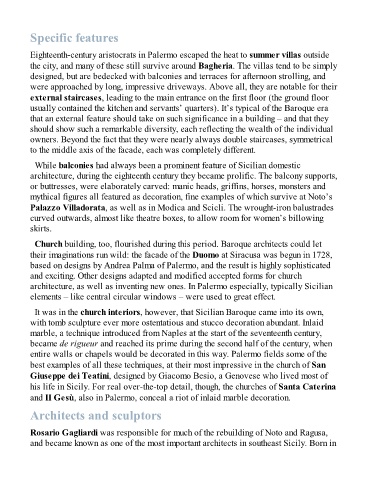Page 586 - The Rough Guide of Sicily
P. 586
Specific features
Eighteenth-century aristocrats in Palermo escaped the heat to summer villas outside
the city, and many of these still survive around Bagheria. The villas tend to be simply
designed, but are bedecked with balconies and terraces for afternoon strolling, and
were approached by long, impressive driveways. Above all, they are notable for their
external staircases, leading to the main entrance on the first floor (the ground floor
usually contained the kitchen and servants’ quarters). It’s typical of the Baroque era
that an external feature should take on such significance in a building – and that they
should show such a remarkable diversity, each reflecting the wealth of the individual
owners. Beyond the fact that they were nearly always double staircases, symmetrical
to the middle axis of the facade, each was completely different.
While balconies had always been a prominent feature of Sicilian domestic
architecture, during the eighteenth century they became prolific. The balcony supports,
or buttresses, were elaborately carved: manic heads, griffins, horses, monsters and
mythical figures all featured as decoration, fine examples of which survive at Noto’s
Palazzo Villadorata, as well as in Modica and Scicli. The wrought-iron balustrades
curved outwards, almost like theatre boxes, to allow room for women’s billowing
skirts.
Church building, too, flourished during this period. Baroque architects could let
their imaginations run wild: the facade of the Duomo at Siracusa was begun in 1728,
based on designs by Andrea Palma of Palermo, and the result is highly sophisticated
and exciting. Other designs adapted and modified accepted forms for church
architecture, as well as inventing new ones. In Palermo especially, typically Sicilian
elements – like central circular windows – were used to great effect.
It was in the church interiors, however, that Sicilian Baroque came into its own,
with tomb sculpture ever more ostentatious and stucco decoration abundant. Inlaid
marble, a technique introduced from Naples at the start of the seventeenth century,
became de rigueur and reached its prime during the second half of the century, when
entire walls or chapels would be decorated in this way. Palermo fields some of the
best examples of all these techniques, at their most impressive in the church of San
Giuseppe dei Teatini, designed by Giacomo Besio, a Genovese who lived most of
his life in Sicily. For real over-the-top detail, though, the churches of Santa Caterina
and II Gesù, also in Palermo, conceal a riot of inlaid marble decoration.
Architects and sculptors
Rosario Gagliardi was responsible for much of the rebuilding of Noto and Ragusa,
and became known as one of the most important architects in southeast Sicily. Born in

